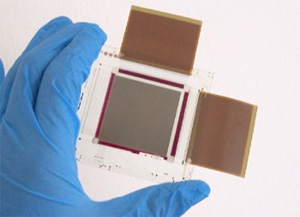
The performance of flexible large-area organic photodiodes has now advanced to the point where they can provide more functionality than previous silicon photodiode technologies, especially in applications such as biomedical imaging and biometric monitoring that require the detection of large-area low level light.
The results we have achieved demonstrate for the first time that these devices generated from solutions at low temperatures can detect visible light with fewer than hundreds of thousands of photons per second, similar to the amount of light that stars in dark skies reach our eyes, "said Canek Fuentes Hernandez, principal research scientist at the School of Electrical and Computer Engineering at Georgia Tech. The ability to coat these materials on large-area substrates with arbitrary shapes means that flexible organic photodiodes now have a significant advantage over state-of-the-art silicon photodiodes in applications that require response times in the range of tens of microseconds.

The November 6th issue of Science magazine introduced the development and performance of large-area low-noise organic photodiodes. This study was supported by multiple organizations including the Naval Research Office, Air Force Science Research Office, and the National Nuclear Security Administration of the US Department of Energy.
Organic electronic devices are based on materials made from carbon based molecules or polymers, rather than existing inorganic semiconductors such as silicon. This type of device can be manufactured using simple solutions and inkjet printing technology, rather than the expensive and complex processes found in existing electronic product manufacturing. At present, this technology is widely used in devices such as displays and solar cells.
Organic photodiodes use polyethyleneimine. This is a surface modifier containing amine polymer substances, developed by Professor Joseph M. Pettit and Bernard Kippelen's laboratory at Georgia Institute of Technology. It was found that air is stable and can form electrodes with low working function. The use of polyethyleneimine has also demonstrated the ability to produce photovoltaic devices with low dark current levels, allowing current to flow through the devices even in the dark. This means that this material works in photodetectors and can capture weak signals of visible light.
Over the years, the level of dark current has significantly decreased, and in order to detect electronic noise corresponding to one millionth of a second of an electron fluctuation, the measuring instrument must be redesigned, "said Fuentes Hernandez, the first author of the paper. This work reflects the continuous efforts of the Kippelen Group's team for over 6 years, including recent graduates Talha Kahn and part of the doctoral program at Wenfang Chou. The efforts of these groups have generated the scientific insights needed to demonstrate organic photodiodes with this level of performance
One application of the new device is a pulse oximeter, which is now placed on the finger to measure heart rate and blood oxygen levels. Organic photodiodes can be placed on multiple devices on the body, and the amount of light used during operation may be 10 times less than traditional devices. In this way, wearable health monitors can be used for better physiological information and continuous monitoring without frequent battery replacement. Other potential applications include human-machine interfaces, such as non-contact gesture recognition and control.
One future application is scintillation detection of ionizing radiation, which produces a flash when a fluorescent material hits high-energy particles. If the detectable light level is reduced, the sensitivity of the device will increase and it can detect low-level radiation. Detecting radiation from vehicles and containers requires a large detection area, and organic photodiodes are easier to manufacture than silicon photodiode arrays.
Organic photodiodes also have the same advantages in X-ray devices, and doctors hope to minimize the amount of radiation transmitted to patients with as little radiation as possible. Here, the sensitivity, large area, and flexible external dimensions should also make organic photodiodes more advantageous than silicon-based arrays.
We are working hard to improve the response time of the photodetector. Because producing high-speed photodetectors can achieve many important applications. Mr. Fuentes Hernandez said. It is indeed necessary to develop more scalable photodetector technology. One of the motivations for this work is to advance the expansion of economically efficient organic technologies that we know of
Organic photodiodes can display electronic noise current values within the range of tens of amperes and noise equivalent power values of hundreds of kilowatts. In terms of response time, the important performance element of organic photodiodes is superior to silicon, and researchers are striving to improve it by 100 times to achieve future applications.
Kippelen said, 'The materials we use are processed from ink using printing technology, so they are not as ordered as crystalline materials.' Therefore, the movement speed and speed of the carrier that can move through these materials are very low, so we cannot obtain the same high-speed signal as silicon. '. However, many applications do not require response times on the order of picoseconds or nanoseconds
For Kippelen, the operation of photodiodes demonstrates the achievements of 25 years dedicated to improving the performance of organic electronic materials. This work is part of the Center for Organic Photonics and Electronics at Georgia Tech, continuing to explore fundamental science and improve material performance in conjunction with extensive device modeling.
Kippelen said, "Organic thin films absorb light more effectively than silicon, so the overall thickness that absorbs this light must be very small." Even if you expand those areas, the overall volume of your detector is still very small, using organic materials. Increasing the area of the silicon detector will increase the volume of the material and generate a large amount of electronic noise at room temperature
The thickness of the active layer used in the photodiode produced in Kippelen laboratory is only 500 nanometers. One gram of material, only the size of a finger, can be applied to the surface of a table.
Hot
-
In depth analysis of the working principle of MOS transistor
2025-05-19
-
Comprehensive Analysis and Recommendation of MOS Tube Brands
2025-05-19
-
A Comprehensive Guide to MOS Tube Selection
2025-05-19
-
The vast prospects and development trends of the MOS transistor market
2025-05-19
-
Comprehensive analysis of MOS transistor performance parameters
2025-05-19
-
In depth Analysis of MOS Tube Price Trends
2025-05-19
-
A comprehensive guide for troubleshooting MOS transistor faults
2025-05-19
-
Analysis of the Growth Trend of Trench Mosfet Market
2025-05-19
-
Analysis of MOSFET Working Principle
2025-05-19
-
A Comprehensive Guide to MOS Tube Selection
2025-05-19

